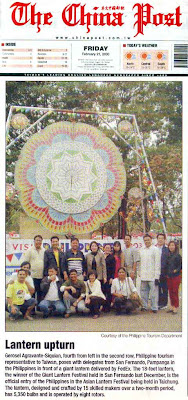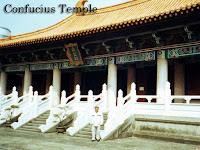
I arrived in Kuala Lumpur from Penang late in the evening. Of course, the first thing we did was go for a late dinner. If I remember it right, it was at a
mamak which served
roti canai, beef
murtabak and
teh tarik.
September 19: The next day, I think we went shopping since the only thing I could remember was that we passed by KL's
Central Market. That evening too, Leon took a bus from Singapore to join us in KL.
 September 20
September 20: We decided to go to Malacca (
Melaka) and meet up with Shyamala, another SSEAYP batchmate who lived there. Aside from me, Kenneth and Leon, two Filipino friends of Kenneth joined us.
Since I had been to Malacca the previous year during the SSEAYP program, we didn't go around much. I hadn't realized it then but I had actually visited the three major towns of the
Straits Settlements (
Singapore,
Penang and
Malacca) during the trip.

Just like Penang, Malacca had its own heritage trail sponsored too by American Express. We started at the Town Center of Malacca Town. One of the major structures there is
Stadthuys. which according to the Melaka website was built in 1650 as the official residence of Dutch Governors and Deputy Governors. It adds that "the edifice is a fine example of Dutch architecture, with solid doors and louvred windows. Believed to be the oldest Dutch building in the East, the port-red theme extends to the other buildings around the Town Square and the old clock tower."
Also painted in port-red is
Christ Church which was completed in 1753. Inside this Dutch church are 200-year old pews, an altar painting of the Last Supper on glazed tiles, as well as 15-meter beams each made from a single tree.

From the Town Center, we walked straight to Jonker Street (
Jalan Hang Jebat) which is a cluster of art galleries, antique and souvenir shops, as well as traders of traditional items, "among them goldsmiths, watch repairers, clog makers and beaded shoemakers, blacksmiths, rattan and bamboo weavers, Chinese traditional medicine merchants and food outlets."
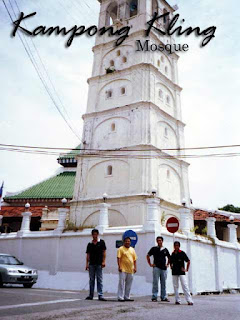
Also in the area were several mosques and temples, among them the
Kampong Kling Mosque, one of the oldests mosques in Malaysia which has Sumatran architectural features; and the
Cheng Hoon Teng Temple which was built in 1646 and is thus the oldest Chinese temple in Malaysia.
One of the must see sights which I got to visit the previous year is
A'Famosa, the "hallmark of Melaka and perhaps the most photographed subject next to the Stadthuys. Built by the Portuguese in 1511 as a fortress it sustained severe structural damage during the Dutch Invasion. The British had set to destroy it but timely intervention by Sir Stamford Raffles in 1808 saved what remains of A' Famosa today."
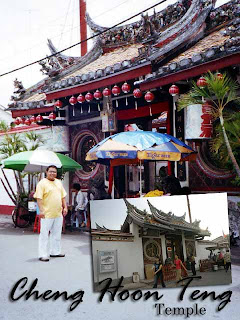
Also visit the ruins of
St. Paul's Church, where the remains of St. Francis Xavier were briefly enshrined in the open grave in 1553 before they were brought to Goa, India.
When it comes to food, don't miss the
Baba-Nyonya cuisine which is unique to Malacca. The Baba-Nyonya are the Straits Chinese, descendants of very early Chinese immigrants who partially adopted Malay customs. Another collective term for these immigrants is Peranakan which refers to descendants of foreigners who had assimilated into the local community. There are Indian Peranakans called
Chitty and Eurasian Peranakans known as
Kristang. In the Philippines, we had the
mestizos de Sangley, with Tsinoy as its modern day equivalent

After that long day in Malacca, Shyamala joined us back to KL where we met up with another batchmate Andrea. The five of us went up to
Genting Highlands for the evening. It is a 2000-meter high peak which is occupied by a mountain resort called Genting - City of Entertainment. They call it the Las Vegas of Malaysia since it is the only legal land-based casino in Malaysia. Aside from the casinos complex and the world-class hotels, other facilities in this resort include a theme park, golf course, shopping malls, sky diving simulator, concert hall and many more
September 21: It was a Sunday and we didn't do much. Leon had to commute back to Singapore since he had work on Monday. All I remember was we just kept on eating, and eating, and eating since Kenneth was very eager to let me try as much Malaysian hawker food as possible.
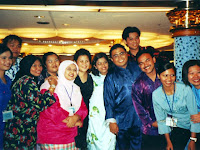 September 22
September 22: The M/S Nippon Maru docked in Port Klang. I attended the welcome ceremonies in the afternoon as well as the reception on board the ship in the evening. I had to leave immediately after the reception since I had to rush back to KL which was about an hour away to catch the 11:50 p.m. bus back to Singapore.
Septermber 23: I arrived in Singapore early in the morning. I think I took a nap after breakfast. I was in Changi Airport by early afternoon for my Singapore Airlines flight back to Manila.
Related entries
Melaka, Malaysia is a historic city of the Straits of MalaccaExploring the Penang heritage trail on footBus trip from Kuala Lumpur to Penang, Malaysia Following the heritage trail in Penang
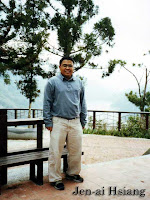 Since we had been in Taichung the whole time and usually did nothing during the day, our Taiwanese guide Frank, who worked with the MECO office in Taichung, arranged for a van to take us to this place he called "snowy mountain." We didn't know where exactly we were going since all the names were in Mandarin. But since we were yearning to go around, we said yes.
Since we had been in Taichung the whole time and usually did nothing during the day, our Taiwanese guide Frank, who worked with the MECO office in Taichung, arranged for a van to take us to this place he called "snowy mountain." We didn't know where exactly we were going since all the names were in Mandarin. But since we were yearning to go around, we said yes.  On the way, our group paid a courtesy call to Mr. Yukan Nafu, chief of Jen-ai Hsiang (Ren-ai Township) in Nantou County. The place reminded me so much of our laidback mountain towns in the Cordilleras. The mountain climate was very pleasing to the senses. It's sad Baguio City air is no longer as clean as it used to be and you really have to go into the rural areas to enjoy nature at its finest.
On the way, our group paid a courtesy call to Mr. Yukan Nafu, chief of Jen-ai Hsiang (Ren-ai Township) in Nantou County. The place reminded me so much of our laidback mountain towns in the Cordilleras. The mountain climate was very pleasing to the senses. It's sad Baguio City air is no longer as clean as it used to be and you really have to go into the rural areas to enjoy nature at its finest.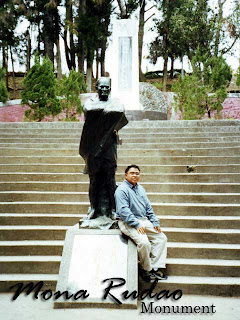 Also in Ren-ai, we dropped by the Mona Rudao Monument, which was erected to honor Mona Rudao, a chief of the Atayal Tribe, who led his tribe people in the Wushe Anti-Japanese Incident.
Also in Ren-ai, we dropped by the Mona Rudao Monument, which was erected to honor Mona Rudao, a chief of the Atayal Tribe, who led his tribe people in the Wushe Anti-Japanese Incident. The fog was so thick, it was difficult to see things around. So obviously, the view of the mountains was blocked as well. In fact, it was so cold, it was actually snowing. Near the marker were several makeshift stalls which sold hot meals such as noodles and grilled sausages. It was good someone posted his photos of Wuling so I was able to see the view of the mountains sans the thick fog.
The fog was so thick, it was difficult to see things around. So obviously, the view of the mountains was blocked as well. In fact, it was so cold, it was actually snowing. Near the marker were several makeshift stalls which sold hot meals such as noodles and grilled sausages. It was good someone posted his photos of Wuling so I was able to see the view of the mountains sans the thick fog. We didn't stay too long up there since it was freezing cold and there was nothing to see at that time. Winter is not a good time to go up. So the group made its way down the mountain again.
We didn't stay too long up there since it was freezing cold and there was nothing to see at that time. Winter is not a good time to go up. So the group made its way down the mountain again.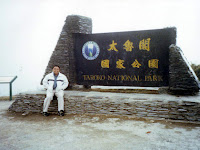 Maybe if I get the chance, I should come back here during the summer months. The brochure of Taroko National Park has very enticing photos of the many natural attractions of the park. We decided to rest early that night since we were going to Taipei the next day.
Maybe if I get the chance, I should come back here during the summer months. The brochure of Taroko National Park has very enticing photos of the many natural attractions of the park. We decided to rest early that night since we were going to Taipei the next day.

